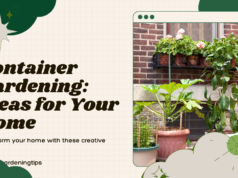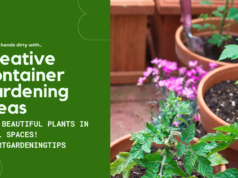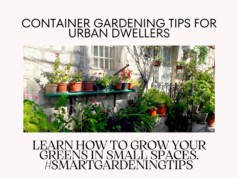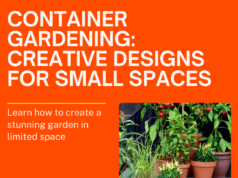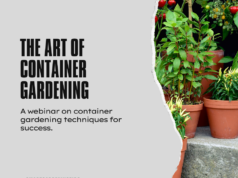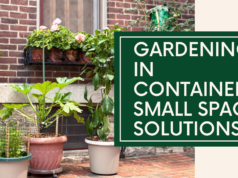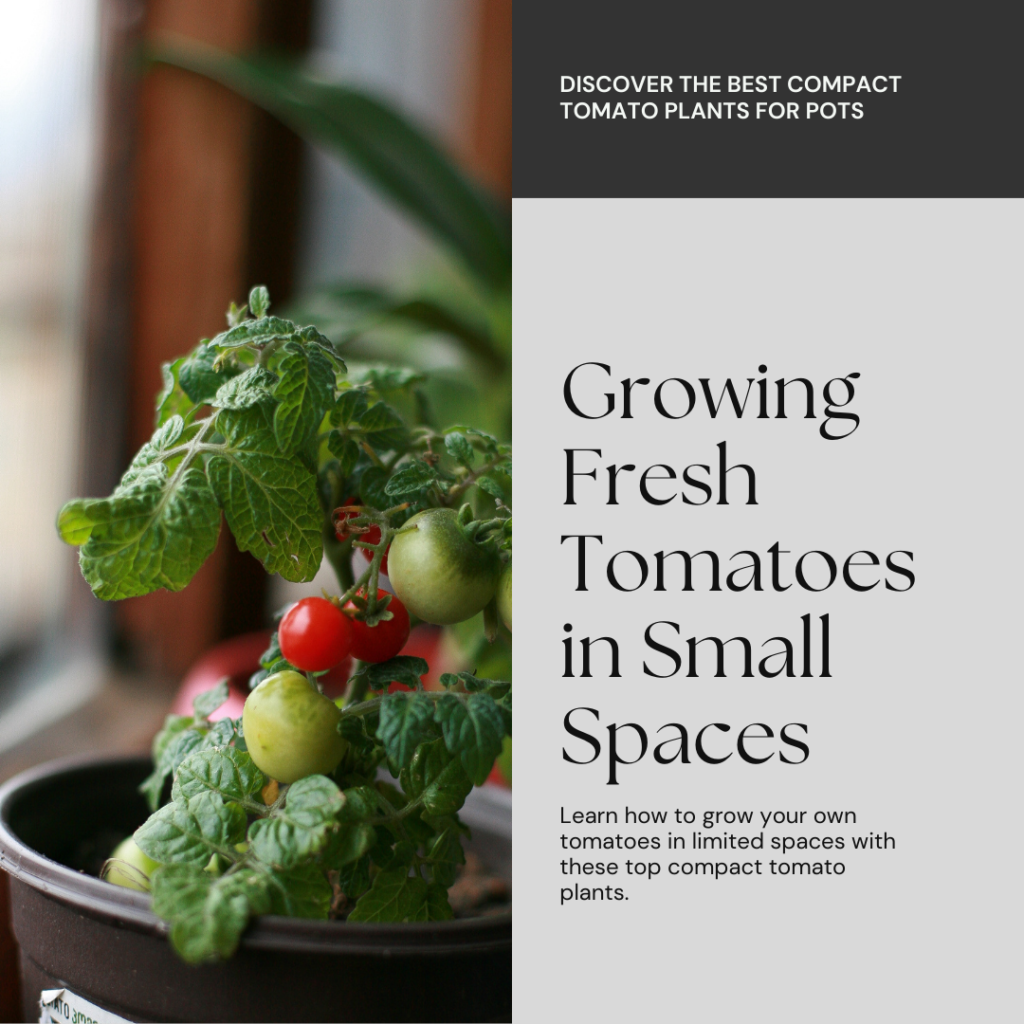
Welcome to the world of tomato gardening, where you can grow juicy, flavorful tomatoes right in your own balcony or patio! If you have limited space but a strong desire to cultivate your own homegrown tomatoes, you’re in the right place. In this article, we will guide you through the best options for growing tomatoes in pots, specifically focusing on compact varieties that are perfect for small spaces like balconies and patios.
Imagine stepping outside and plucking a ripe, sun-kissed tomato from your very own pot garden. The satisfaction of growing your own food and enjoying the freshest flavors cannot be matched. With the right plants and proper care, you can have a bountiful harvest of tomatoes, no matter the size of your gardening space.
Key Takeaways:
- Compact tomato plants are ideal for small spaces like balconies and patios.
- Cultivating your own homegrown tomatoes allows you to enjoy the freshest flavors.
- The right plants and proper care can lead to a bountiful harvest in pots.
Tiny Tim Tomato Overview
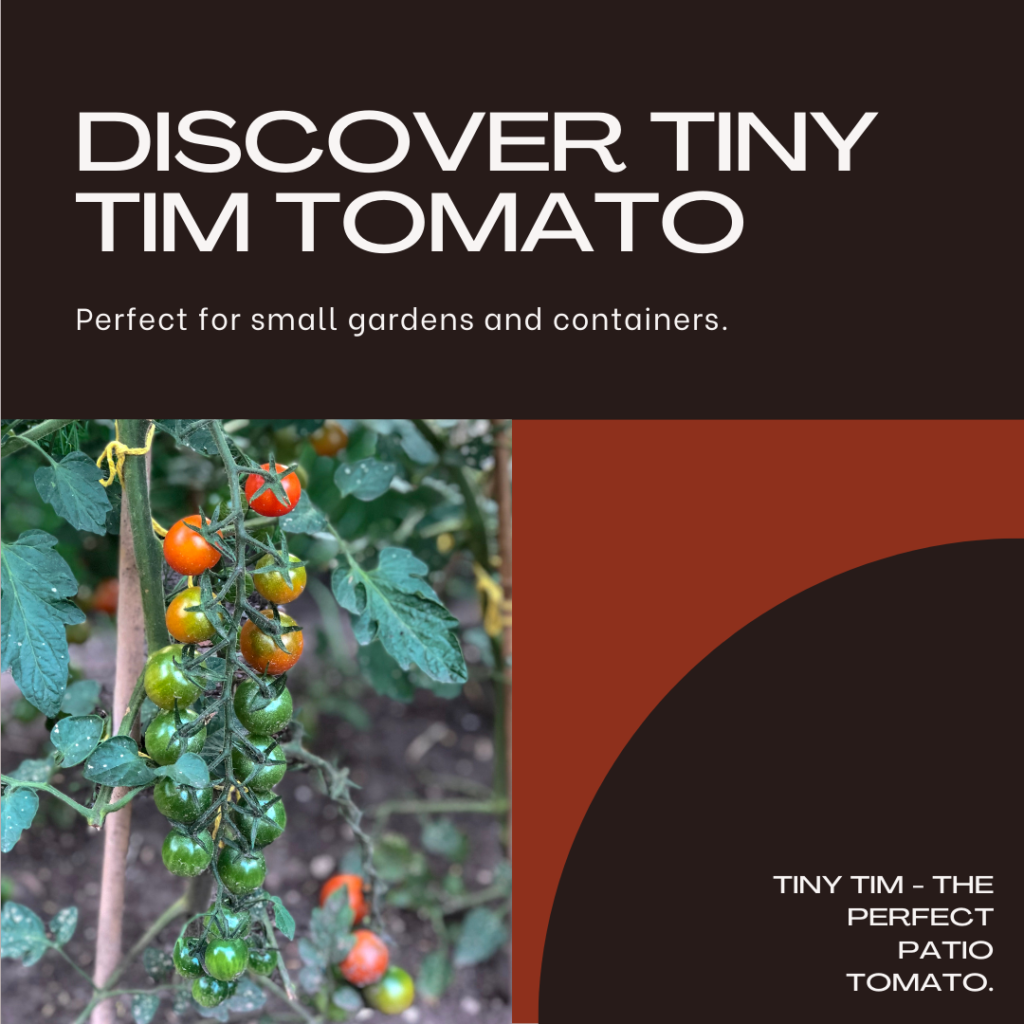
The Tiny Tim tomato is a fantastic choice for pot gardening, especially if you have limited space. This variety is known for its compact size and high yields, making it perfect for growing in pots on balconies or patios. Whether you’re a beginner or an experienced gardener, the Tiny Tim tomato is a great addition to your pot garden.
Characteristics of the Tiny Tim Tomato
The Tiny Tim tomato plants typically grow to a height of 12-18 inches, making them ideal for small pots or containers. Despite their small size, these plants produce an abundance of cherry-sized tomatoes that are packed with flavor. The fruits are bright red and have a sweet, tangy taste that is perfect for salads, snacks, or even homemade salsa.
Growing the Tiny Tim tomato in pots is relatively easy, even for novice gardeners. These plants require less space and have a shorter growing season compared to larger tomato varieties, making them suitable for gardeners with limited time and resources. With a little care and attention, you can enjoy a bountiful harvest of delicious Tiny Tim tomatoes right from your own pot garden.
“The Tiny Tim tomato is perfect for those who want to grow tomatoes in small spaces. Its compact size and high yields make it an excellent choice for pot gardening on balconies or patios.” – Tom, Expert Gardener
Tips for Growing Tiny Tim Tomatoes in Pots
If you’re planning to grow Tiny Tim tomatoes in pots, here are some essential tips to ensure the best results:
- Choose a pot or container that is at least 12 inches deep and wide to provide enough space for the roots to grow.
- Use well-draining potting soil that is rich in organic matter. This will help promote healthy root development and prevent waterlogging.
- Place the pots in a sunny spot, as Tiny Tim tomatoes require at least 6-8 hours of direct sunlight per day for optimal growth and fruit production.
- Water the plants consistently, keeping the soil moist but not waterlogged. Check the moisture level regularly and adjust your watering schedule accordingly.
- Apply a balanced fertilizer once a month to provide the necessary nutrients for healthy growth and fruit production.
- Support the plants with stakes or cages to keep them upright as the tomatoes start to develop.
- Monitor the plants for pests, such as aphids or whiteflies, and take appropriate measures to control them.
By following these tips, you’ll be well on your way to growing a thriving pot of Tiny Tim tomatoes. Enjoy the satisfaction of harvesting your own homegrown tomatoes and savor the flavors of summer in every bite!
Tumbling Tom Tomato Characteristics
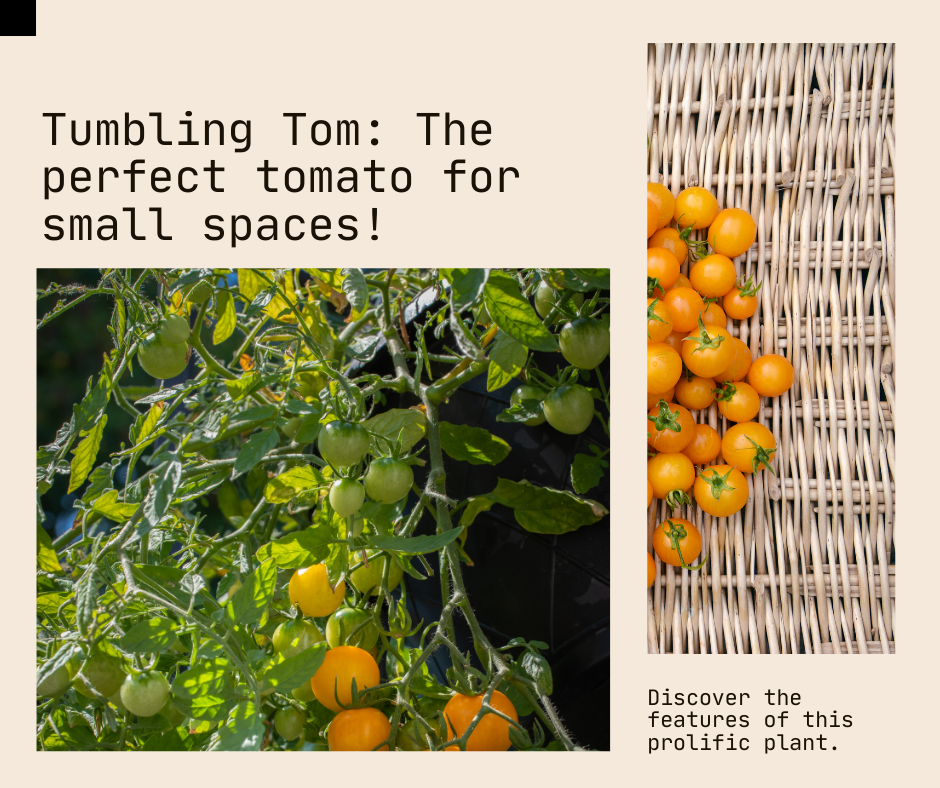
The Tumbling Tom tomato is a delightful variety that adds a touch of whimsy to any pot garden. With its trailing vines, this tomato is perfect for cascading over the edges of pots or hanging baskets, creating a stunning display. Let’s explore the unique characteristics of the Tumbling Tom tomato and discover how to care for this variety in containers.
Compact and Cascading
The Tumbling Tom tomato is known for its compact size, making it ideal for small spaces such as balconies, patios, or even windowsills. It grows in a trailing manner, cascading down the sides of containers in a beautiful and eye-catching fashion. This makes it an excellent choice for vertical gardens, adding a touch of greenery and vibrancy to any space.
Abundant Harvests
Despite its diminutive size, the Tumbling Tom tomato does not compromise on yield. This variety is known for its generous production of juicy and flavorful tomatoes. You can expect a bountiful harvest throughout the growing season, providing you with an abundance of homegrown goodness to enjoy.
Caring for Tumbling Tom Tomatoes in Containers
To ensure the success of your Tumbling Tom tomatoes in containers, here are a few care tips to keep in mind:
- Choose the right container: Select a container of appropriate size to accommodate the spreading habit of the Tumbling Tom tomato. Ensure that the container has drainage holes to prevent waterlogging.
- Quality soil: Use a well-draining potting mix enriched with organic matter. This will provide the necessary nutrients for healthy growth.
- Sunlight: Place your Tumbling Tom tomato in a location that receives at least 6-8 hours of direct sunlight each day. Tomatoes thrive in sunny conditions.
- Watering: Regular watering is crucial for the success of container-grown tomatoes. Keep the soil evenly moist, avoiding both drought and waterlogging.
- Fertilization: Feed your Tumbling Tom tomato regularly with a balanced fertilizer to support its growth and fruit production. Follow the manufacturer’s instructions for application rates.
- Support if needed: While the Tumbling Tom tomato is naturally cascading, you may need to provide support for heavier clusters of tomatoes. Gently tie the vines to stakes or trellises to prevent them from breaking under the weight of the fruit.
By following these care tips, you can ensure that your Tumbling Tom tomatoes thrive and provide you with a season full of delicious, homegrown tomatoes.
| Tumbling Tom Tomato Characteristics | |
|---|---|
| Plant Type | Determinate |
| Size | Compact, trailing vines |
| Fruit Size | Small to medium |
| Fruit Color | Red or yellow |
| Flavor | Sweet and tangy |
| Harvest Time | 60-75 days |
| Container Suitability | Perfect for pots and hanging baskets |
Patio Princess Tomato Features
If you have limited space but still want to enjoy juicy tomatoes, the Patio Princess variety is perfect for you. These compact tomatoes are specifically bred for small spaces like balconies and patios, making them an excellent choice for urban gardeners.
The Patio Princess tomato offers a range of features that make it ideal for cultivation in small spaces:
- Plant Size: The Patio Princess tomato is a determinate variety, meaning it grows to a predetermined size and stops growing. This compact plant typically reaches a height of about 24 to 36 inches, making it well-suited for container gardening.
- Yield: Don’t be fooled by its size—despite being compact, the Patio Princess tomato is known for its generous yield. Each plant can produce a large number of delicious tomatoes, ensuring you have an abundant harvest.
- Flavor: The Patio Princess tomato produces juicy and flavorful fruits that are perfect for fresh eating. Whether you enjoy them in salads, sandwiches, or sauces, the sweet and tangy taste of these tomatoes will elevate any dish.
- Growth Habit: This variety has a more upright growth habit, allowing it to be easily staked or supported. It also adapts well to hanging baskets or cascading over the sides of containers, adding a beautiful touch to your small space garden.
Tips for Cultivating Patio Princess Tomato in Small Spaces:
To ensure successful cultivation of the Patio Princess tomato in small spaces, here are some tips to keep in mind:
- Container Size: Choose a container that is at least 10 to 12 inches deep and wide with adequate drainage. This will provide enough room for the roots to grow and prevent waterlogging.
- Sunlight: Place your Patio Princess tomato plant in a spot that receives at least 6 to 8 hours of direct sunlight daily. Adequate sunlight is crucial for the plant’s growth and fruit production.
- Watering: Tomatoes need consistent moisture, so water your Patio Princess regularly, keeping the soil evenly moist. Avoid overwatering, as it can lead to root rot.
- Support: If growing your Patio Princess tomato in pots, provide support such as a stake or cage to keep the plant upright as it reaches full maturity.
- Pruning: Regularly remove suckers—small shoots that grow between the main stem and branches—to maintain a more compact plant and redirect energy towards fruit production.
- Fertilization: Use a balanced tomato fertilizer according to the package instructions to provide essential nutrients for healthy growth and optimal fruit development.
By following these tips, you can cultivate thriving Patio Princess tomato plants in small spaces and enjoy a bountiful harvest of tasty tomatoes straight from your own balcony or patio garden.
| Features | Description |
|---|---|
| Plant Size | Compact, reaching a height of 24-36 inches |
| Yield | Generous harvest of delicious tomatoes |
| Flavor | Juicy and flavorful fruits, perfect for fresh eating |
| Growth Habit | Upright growth suitable for staking or cascading |
Micro Tom Tomato Profile
If you’re looking to grow tomatoes in extremely confined spaces, the Micro Tom tomato is the perfect choice. Despite its small size, this variety offers big rewards. Let’s explore the unique characteristics of the Micro Tom tomato and discover the best practices for nurturing these tomatoes in pots.
Characteristics of Micro Tom Tomato
The Micro Tom tomato is a true dwarf variety, reaching a compact height of only 6 to 8 inches. This makes it an excellent option for small gardens, balconies, or even windowsills.
Despite its miniature size, the Micro Tom tomato produces an abundance of cherry-sized fruits. These tomatoes are known for their intense flavor and sweet juiciness, making them a favorite amongst tomato enthusiasts.
One of the remarkable traits of the Micro Tom tomato is its accelerated growth rate. It matures quickly, allowing you to enjoy a bountiful harvest in just 45 to 50 days from planting.
Best Practices for Nurturing Micro Tom Tomato in Pots
When growing Micro Tom tomatoes in pots, it’s essential to follow these best practices:
- Choose the right pot: Select a pot with a minimum depth of 8 inches to provide enough space for root development. Opt for a pot with drainage holes to ensure proper water drainage.
- Use quality potting soil: Fill the pot with well-draining potting soil that is rich in organic matter. This will provide the necessary nutrients and ensure healthy growth.
- Position in a sunny location: Place the pot in a spot that receives at least 6 to 8 hours of direct sunlight daily. The Micro Tom tomato thrives in warm and sunny conditions.
- Water consistently: Keep the soil consistently moist, but avoid overwatering. Aim to water the plant when the top inch of soil feels dry.
- Support the plant: Since the Micro Tom tomato produces heavy clusters of fruit, providing support with a small stake or cage may be necessary to prevent the plant from bending or breaking.
- Fertilize regularly: Feed the Micro Tom tomato with a balanced fertilizer every 2 to 3 weeks to ensure continuous growth and fruit production.
By following these best practices, you can enjoy a thriving Micro Tom tomato plant and savor its delicious fruits even in the smallest of spaces.
Bush Early Girl Tomato Traits
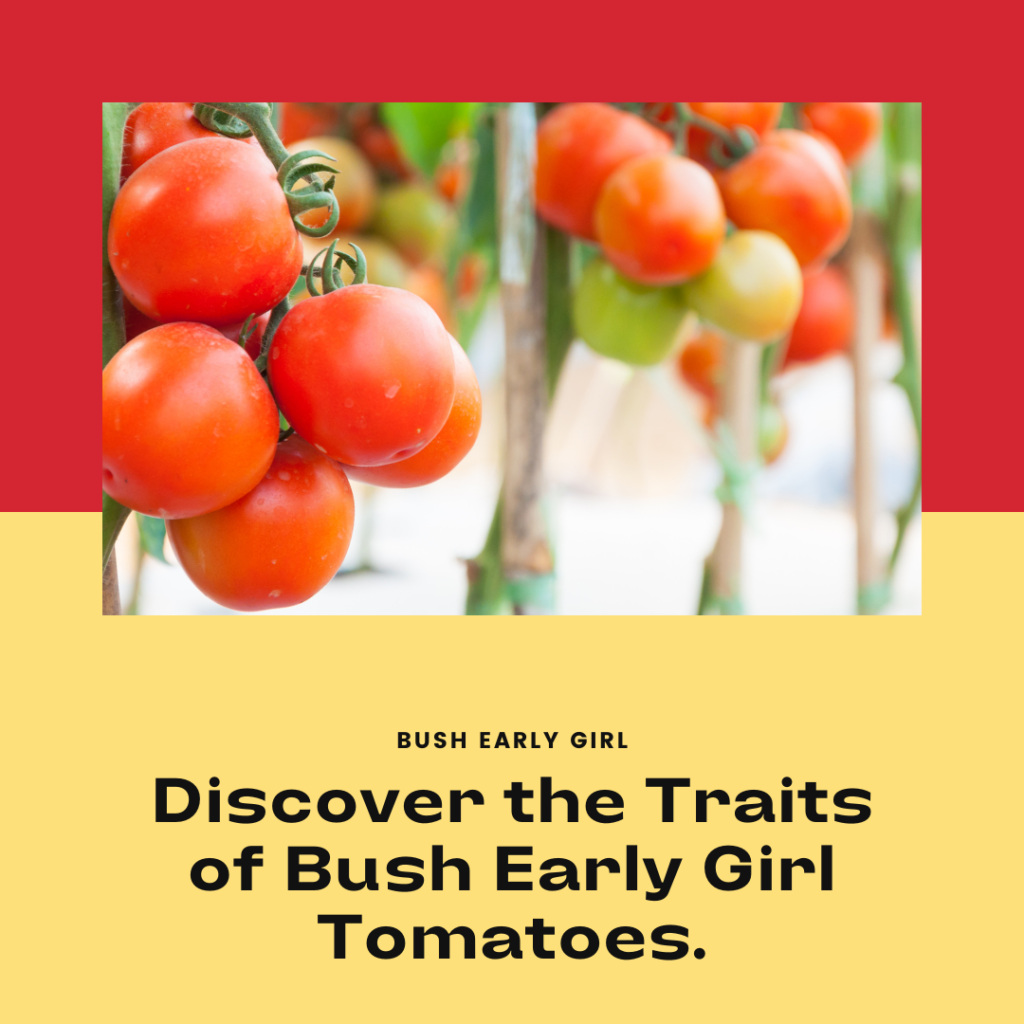
The Bush Early Girl tomato is an excellent choice for gardeners with limited space. This compact variety not only produces delicious tomatoes but also matures early, allowing you to enjoy a bountiful harvest sooner. Whether you have a small balcony, patio, or even a windowsill, the Bush Early Girl tomato is perfect for growing in compact spaces.
One of the standout traits of the Bush Early Girl tomato is its bushy growth habit. Unlike traditional sprawling tomato plants, this variety stays compact and bushy, reaching a height of around 18-24 inches (46-61 cm) and spreading to about 24-36 inches (61-91 cm) wide.
In terms of flavor, the Bush Early Girl tomato offers a delightful balance of sweetness and tanginess. The medium-sized fruits have a rich, classic tomato taste that is perfect for salads, sandwiches, and sauces. Plus, these tomatoes are known for their juicy texture, making them a popular choice among home gardeners.
When it comes to cultivation, the Bush Early Girl tomato is relatively easy to grow. Here are some tips to help you succeed:
- Choose a location that receives at least six hours of direct sunlight daily. Place your potted Bush Early Girl tomato plant in the sunniest spot available to maximize its growth potential.
- Plant your tomato in a well-draining potting mix enriched with organic matter. This will ensure proper root development and optimal nutrient absorption.
- Water your tomato plant consistently, aiming to keep the soil evenly moist. Avoid overwatering, as this can lead to root rot. Mulching around the base of the plant can help retain moisture and reduce weed growth.
- Support your Bush Early Girl tomato plant with a tomato cage or stakes, especially if the fruits start to weigh down the branches. This will prevent bending and breakage, ensuring a healthier and more productive plant.
- Feed your tomato plant with a balanced slow-release fertilizer or use organic options such as compost or worm castings. Follow the instructions on the fertilizer package for the correct application rates.
- Regularly monitor your tomato plant for any signs of pests or diseases. Early detection will allow for prompt treatment, minimizing the impact on plant health and yield.
By following these guidelines, you can successfully grow your own bush Early Girl tomatoes in compact spaces and enjoy the satisfaction of harvesting fresh, flavorful tomatoes from your own pot garden.
Remember, the Bush Early Girl tomato is a versatile variety that thrives in pots and other small spaces. Whether you’re a beginner gardener or an experienced tomato enthusiast, this compact tomato plant is a great addition to any garden.
Choosing the Right Pot for Tomato Plants
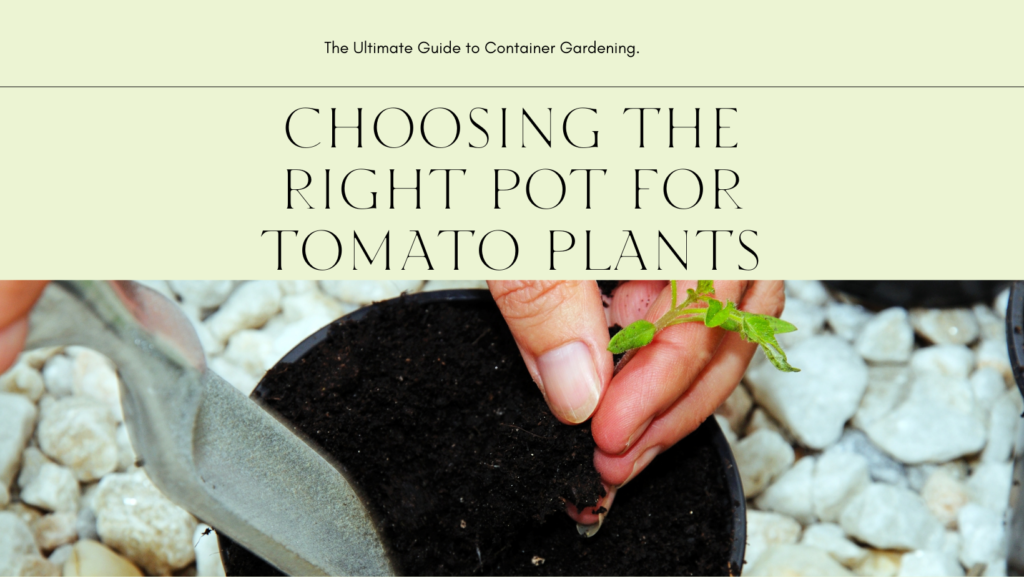
When it comes to pot gardening and growing tomato plants, choosing the right pot is essential for the health and productivity of your plants. The pot you select will directly impact the growth and overall success of your tomatoes. In this section, we will discuss the factors you need to consider when choosing a pot for your tomato plants to ensure optimal growth and abundant harvests.
Factors to Consider
Here are some key factors to keep in mind when selecting a pot for your tomato plants:
- Size: Tomato plants require sufficient space for their roots to grow and spread. Choose a pot that is deep and wide enough to accommodate the root system of your chosen tomato variety.
- Drainage: Good drainage is crucial for tomato plants to prevent waterlogging, which can lead to root rot. Look for pots with drainage holes to ensure excess water can escape.
- Material: There are various pot materials available, such as plastic, clay, or fabric. Consider factors like durability, insulation properties, and weight when selecting the material.
- Insulation: Opt for a pot that provides insulation to regulate soil temperature, especially during extreme weather conditions. This can help prevent stress and promote healthy growth.
- Appearance: While aesthetics may not affect the growth of your plants, choosing a visually pleasing pot can enhance the overall appeal of your pot garden.
By taking these factors into account, you can choose a pot that creates the ideal growing environment for your tomato plants, setting them up for success.
“The right pot for your tomato plants is like picking the perfect home for your beloved plants. It provides the foundation for healthy growth, ensuring your plants thrive and reward you with bountiful harvests.”
Pros and Cons of Different Pot Materials
| Pot Material | Pros | Cons |
|---|---|---|
| Plastic | Durable, lightweight, and easy to clean | May not provide adequate insulation |
| Clay/Terracotta | Natural and breathable, excellent drainage | Prone to cracking, heavy |
| Fabric | Aerates roots, lightweight, and promotes healthy root development | Requires more frequent watering |
The table above provides an overview of the pros and cons of different pot materials, helping you make an informed decision based on your specific needs and preferences.
Remember, choosing the right pot is the first step towards successful pot gardening and ensuring the optimal growth of your tomato plants. Take your time, consider these factors, and select a pot that will provide a nurturing environment for your tomato plants to thrive.
Soil and Fertilizer Requirements for Tomato Plants in Pots
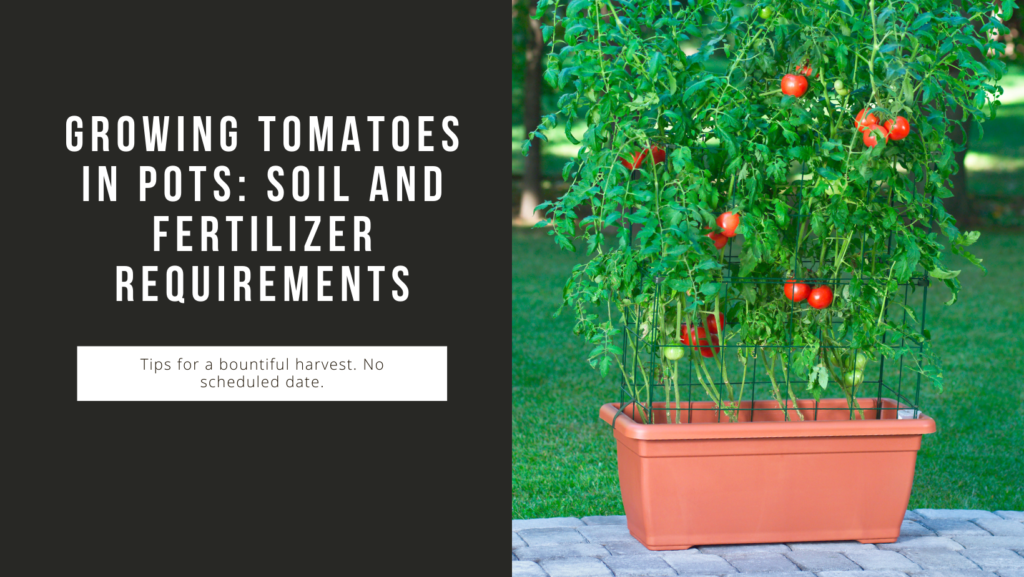
When growing tomato plants in pots, providing the right soil and fertilizer is vital for their overall health and productivity. Understanding the specific requirements of tomato plants will ensure vibrant growth and abundant harvests. Here are some essential tips to meet the soil and fertilizer needs of your tomato plants:
Soil Requirements
Tomato plants thrive in well-draining soil that is rich in organic matter. Look for a high-quality potting mix that is specifically formulated for container gardening. Avoid using garden soil, as it can become compacted in pots and hinder root development. The potting mix should have good water retention capabilities while allowing excess water to drain freely. Additionally, ensure that the pH level of the soil is between 6.0 and 6.8, which is optimal for tomato plants.
Fertilizer Requirements
Tomato plants have specific nutrient requirements throughout their growth stages. Start by incorporating a slow-release organic fertilizer into the potting mix before planting your tomato seedlings. This will provide a steady supply of nutrients over time. As the plants grow, supplement with a balanced liquid fertilizer every two weeks during the growing season. Look for fertilizers labeled specifically for tomatoes or vegetables, as they contain the necessary nutrients such as nitrogen, phosphorus, and potassium.
Remember to follow the specific instructions on the fertilizer packaging regarding application rates and frequency. Over-fertilization can lead to excessive foliage growth at the expense of fruit production.
Regularly monitor the plants for signs of nutrient deficiencies, such as yellowing leaves or stunted growth. Adjust the fertilizer application accordingly to ensure that your tomato plants receive the nutrients they need to thrive.
| Recommended Soil pH | 6.0 – 6.8 |
|---|---|
| Nutrient | Recommended Fertilizer Application |
| Nitrogen | Slow-release organic fertilizer at planting |
| Phosphorus | Balanced liquid fertilizer every two weeks during the growing season |
| Potassium |
Tip: Conduct a soil test before planting your tomato plants to determine the specific nutrient requirements of your soil. This will help you tailor your fertilizer application to meet the specific needs of your plants.
By providing the right soil and fertilizer for your tomato plants in pots, you can ensure their optimal growth and maximize your harvest. Next, we will explore essential watering and pruning tips to further care for your tomato plants in pots.
Watering and Pruning Tips for Tomato Plants in Pots
Proper care and maintenance are essential for the success of your tomato plants in pots. In this section, we’ll provide you with valuable watering and pruning tips to ensure the health and productivity of your tomato plants.
Watering Tips
Tomato plants have specific watering needs, and maintaining the right moisture balance is crucial. Follow these watering tips for optimal growth:
- Consistent watering: Water your tomato plants regularly to keep the soil evenly moist. Inadequate or excessive watering can lead to stunted growth or diseases.
- Avoid waterlogged soil: Ensure proper drainage in your pots by adding drainage holes or using well-draining potting soil. Excess water can suffocate the roots and promote root rot.
- Deep watering: When watering, make sure to saturate the soil deeply. This encourages deep root growth and helps plants withstand dry periods.
- Water at the base: Direct the water at the base of the plants rather than spraying over the leaves. This reduces the risk of fungal diseases and promotes healthier foliage.
Pruning Tips
Pruning helps to control the growth and shape of your tomato plants while improving air circulation and reducing the risk of diseases. Follow these pruning tips to optimize your plant’s growth:
- Remove suckers: Suckers are small shoots that emerge from the leaf axils of tomato plants. Pinch off suckers to focus the plant’s energy on fruit production rather than excessive foliage.
- Remove lower foliage: As your tomato plants grow, remove the lower leaves that touch the ground. This prevents soil-borne diseases and encourages vertical growth.
- Support main stems: Use stakes or cages to support the main stems of your tomato plants. This prevents them from bending or breaking due to the weight of the fruit.
“Pruning your tomato plants not only improves their overall health but also enhances fruit quality. By focusing energy on fruit production and creating a well-ventilated environment, you can enjoy a bountiful harvest of delicious tomatoes.”
Pest and Disease Management for Tomato Plants in Pots
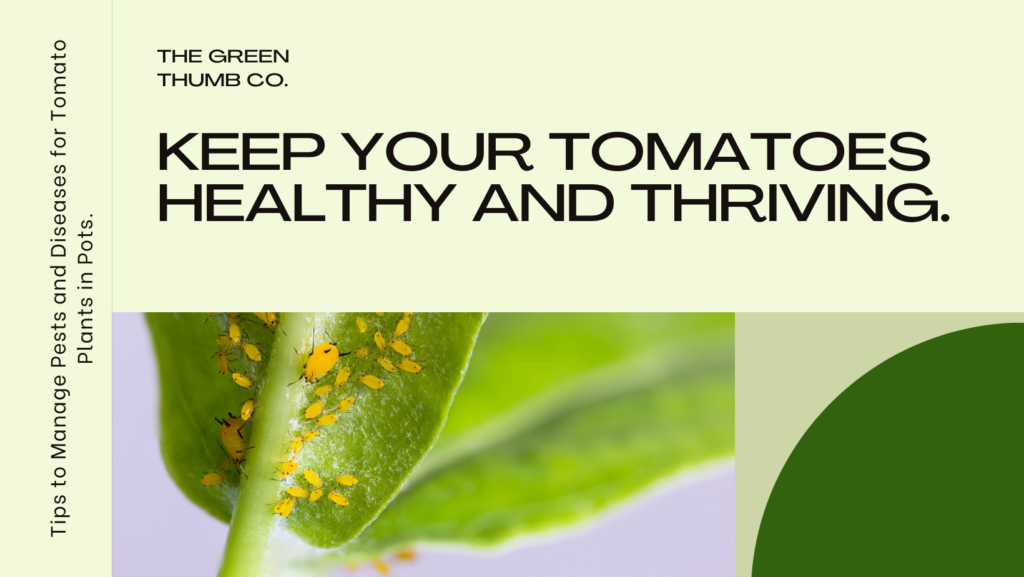
Growing tomato plants in pots offers numerous benefits, but it also comes with specific challenges, such as pest infestation and disease outbreak. To ensure the health and productivity of your tomato plants, it is essential to implement effective pest management and disease prevention strategies.
Pest Management
Tomato plants in pots are vulnerable to a variety of pests, including aphids, whiteflies, and tomato hornworms. These pests can weaken the plants, reduce yield, and even transmit diseases.
To keep these pesky intruders at bay, follow these pest management tips:
- Monitor regularly: Inspect your tomato plants regularly to identify any signs of pest infestation. Look for discolored or distorted leaves, visible pests, or sticky residue on the leaves.
- Natural predators: Encourage beneficial insects, such as ladybugs and lacewings, to make your garden their home. These natural predators will help control aphids and other harmful pests.
- Handpicking: For larger pests like tomato hornworms, manually remove them from the plants and dispose of them appropriately.
- Organic insecticides: If the pest population becomes overwhelming, consider using organic insecticides specifically designed for tomato plants. Always follow the instructions carefully to minimize any negative impact on the environment.
By implementing these pest management practices, you can protect your tomato plants from infestations and ensure healthy growth.
Disease Management
Tomato plants in pots are also susceptible to various diseases, such as blight, wilt, and leaf spot. These diseases can significantly impact the plant’s health and productivity.
Here are some disease management strategies to help safeguard your tomato plants:
- Clean containers: Before planting, ensure that your pots are clean and free from any remnants of previous crops. This helps prevent the transfer of diseases.
- Proper drainage: Ensure your pots have adequate drainage to prevent waterlogged soil, as excessively moist conditions can foster disease development.
- Rotate crops: Avoid planting tomatoes in the same pots or location year after year. Rotating your crops helps break the disease cycle and reduces the risk of infection.
- Avoid overhead watering: Water your tomato plants at the base to minimize the moisture on the leaves. Damp foliage provides a favorable environment for disease-causing pathogens.
- Use disease-resistant varieties: Consider planting disease-resistant tomato varieties, which are bred to have increased resistance to common tomato diseases. Check the seed or plant label for disease resistance information.
By implementing these disease management practices, you can minimize the risk of disease outbreak and support the health of your tomato plants.
Remember, early detection and prompt action are key to effectively managing pests and diseases in your tomato plants. Regularly monitor your plants, maintain good hygiene, and provide optimal growing conditions to ensure a bountiful harvest of perfect and healthy tomatoes.
Harvesting and Enjoying Your Homegrown Tomatoes
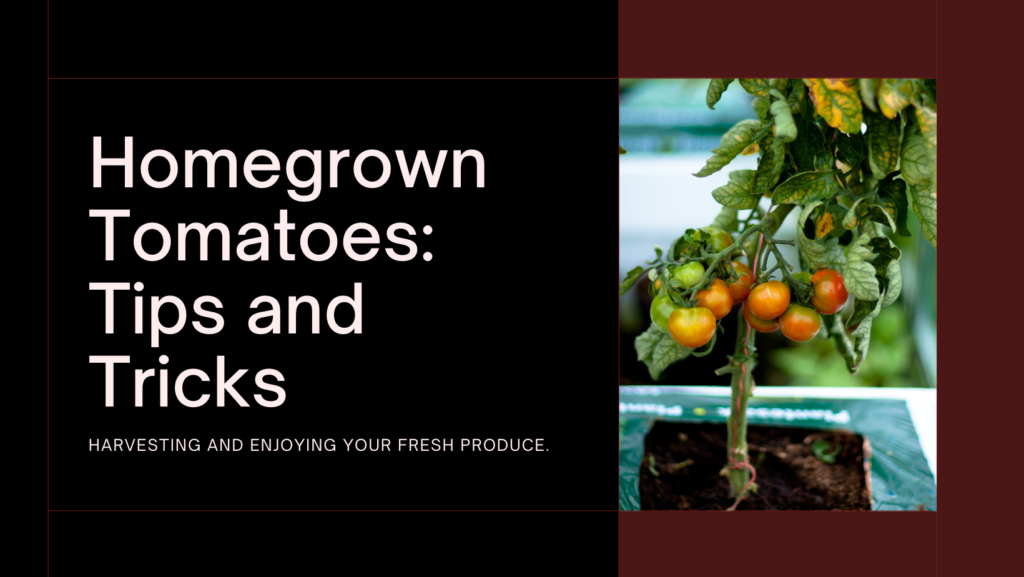
After all the hard work and care, it’s time to harvest your homegrown tomatoes and savor the fruits of your labor. The joy of plucking perfectly ripe tomatoes from your own pot garden is incomparable. In this section, we’ll guide you on the best practices for harvesting tomatoes, as well as provide delicious ways to enjoy them fresh from your garden.
When to Harvest
Knowing when to harvest your tomatoes is key to ensure optimal flavor and quality. Here are some signs to look for:
- Firmness: Your tomatoes should be firm but not overly hard.
- Color: Depending on the variety, the tomatoes should have reached their full color, whether it’s red, orange, yellow, or even green.
- Fruit Drop: Some tomatoes will easily detach themselves from the vine, indicating they are ready to be harvested.
- Taste Test: If you’re unsure, try a sample tomato to assess its flavor. If it’s sweet and delicious, it’s time to start harvesting!
Harvesting Techniques
To harvest your tomatoes without causing damage, follow these simple techniques:
- Hold the tomato gently in one hand and twist it until it detaches from the vine. Avoid pulling or tugging, as it can damage the plant.
- Use clean and sharp pruning shears or scissors to cut the stem a few centimeters above the tomato.
- Handle the tomatoes with care to prevent bruising or crushing.
- If you have a large harvest, consider using a small bucket or basket lined with soft material to cushion the tomatoes and prevent bruising.
Remember to wash your harvested tomatoes before consuming them, especially if you plan to eat them raw.
Enjoying Your Harvest
Once you’ve harvested your homegrown tomatoes, there are countless ways to enjoy their incredible flavor. Here are some ideas to get you started:
“Homegrown tomatoes are the epitome of freshness and taste. They are perfect for creating simple yet satisfying dishes that highlight their natural sweetness and juiciness.”
| Recipe | Description |
|---|---|
| Caprese Salad | A classic Italian salad that combines fresh tomatoes, mozzarella cheese, and basil leaves. Drizzle with olive oil and balsamic glaze for a burst of flavors. |
| Tomato Bruschetta | Grilled bread topped with diced tomatoes, garlic, basil, and a sprinkle of salt and pepper. Simple, yet incredibly delicious. |
| Tomato Sauce | Make your own homemade tomato sauce using fresh tomatoes. It’s perfect for pasta dishes, pizza, and more. |
| Tomato Sandwich | Layer slices of tomatoes on your favorite bread, add some lettuce or basil leaves, and enjoy a refreshing and satisfying sandwich. |
These are just a few ideas to inspire you. The possibilities are endless when it comes to incorporating homegrown tomatoes into your culinary creations.
So go ahead, relish the flavors of your hard work, and share the joy of homegrown tomatoes with friends and family.
FAQ
Q. What are the top compact tomato plants for pots?
A. Some of the top compact tomato plants for pots include the Tiny Tim tomato, Tumbling Tom tomato, Patio Princess tomato, Micro Tom tomato, and Bush Early Girl tomato.
Q. What are the characteristics of the Tiny Tim tomato?
A. The Tiny Tim tomato is a compact variety that produces high yields. It is perfect for growing in pots and requires minimal space. It is known for its small size, early maturity, and sweet flavor.
Q. How do I care for the Tumbling Tom tomato in containers?
A. To care for the Tumbling Tom tomato in containers, make sure to provide ample sunlight, water consistently, and fertilize regularly. Prune the plant to maintain its shape and promote airflow for disease prevention.
What are the features of the Patio Princess tomato?
The Patio Princess tomato is an ideal choice for small spaces. It is a compact variety that produces delicious, juicy tomatoes. It requires minimal maintenance, is disease resistant, and can be easily grown in pots.
Q. What are the unique characteristics of the Micro Tom tomato?
A. The Micro Tom tomato is the smallest variety available, making it perfect for growing in extremely confined spaces. It has a short growing period, reaching maturity within 60-70 days, and produces small cherry-sized tomatoes.
Q. How can I successfully grow the Bush Early Girl tomato in compact spaces?
A. To successfully grow the Bush Early Girl tomato in compact spaces, choose a deep pot with good drainage. Provide adequate sunlight, water consistently, and use a balanced fertilizer. Prune the plant to maintain its compact size and promote optimal growth.
Q. What factors should I consider when choosing the right pot for tomato plants?
A. When choosing a pot for tomato plants, consider the size, material, and drainage capabilities of the pot. Ensure it is large enough to accommodate the plant’s root system, made of a durable material, and has proper drainage holes.
Q. What are the soil and fertilizer requirements for tomato plants in pots?
A. Tomato plants in pots require well-draining soil that is rich in organic matter. Choose a potting mix specifically formulated for containers or make your own by combining potting soil, compost, and perlite. Fertilize regularly using a balanced tomato fertilizer to provide essential nutrients.
Q. What are the watering and pruning tips for tomato plants in pots?
A. When watering tomato plants in pots, ensure the soil is consistently moist but not waterlogged. Avoid overwatering or allowing the soil to dry out completely. Prune the plants by removing suckers and lower leaves to improve airflow, prevent diseases, and encourage better fruit production.
Q. How can I manage pests and diseases in my tomato plants in pots?
A. To manage pests in tomato plants in pots, regularly inspect the plants for signs of infestation and use organic pest control methods like hand-picking insects or using insecticidal soap. Prevent diseases by providing proper spacing between plants, good airflow, and removing any infected leaves or fruits.
Q. When and how should I harvest my homegrown tomatoes?
A. Harvest your homegrown tomatoes when they are fully ripe and have developed their color. Gently twist or cut the tomatoes from the vine, taking care not to damage the plant. They are best enjoyed fresh or used in various culinary preparations.
Conclusion
In conclusion, growing tomato plants in pots is a perfect solution for those who have limited space but still want to enjoy the experience of gardening. The compact tomato varieties discussed in this article, such as Tiny Tim, Tumbling Tom, Patio Princess, Micro Tom, and Bush Early Girl, have been specifically bred to thrive in pots, making them ideal choices for balcony and patio gardening.
By following the tips and techniques provided throughout this article, you can successfully cultivate your very own pot garden filled with fresh, homegrown tomatoes. Remember to carefully choose the right pot size, provide the appropriate soil and fertilizer, maintain correct watering and pruning practices, and manage pests and diseases effectively. Your efforts will be rewarded with vibrant plants and abundant harvests of delicious, homegrown tomatoes.
Imagine the satisfaction of plucking ripe, juicy tomatoes straight from your own pot garden and incorporating them into your favorite dishes. From flavorful salads to savory pasta sauces or even enjoying them on their own, homegrown tomatoes bring a burst of freshness and taste to any meal. With a little effort and creativity, you can create a small urban oasis on your balcony or patio and experience the joys of pot gardening with tomato plants.


